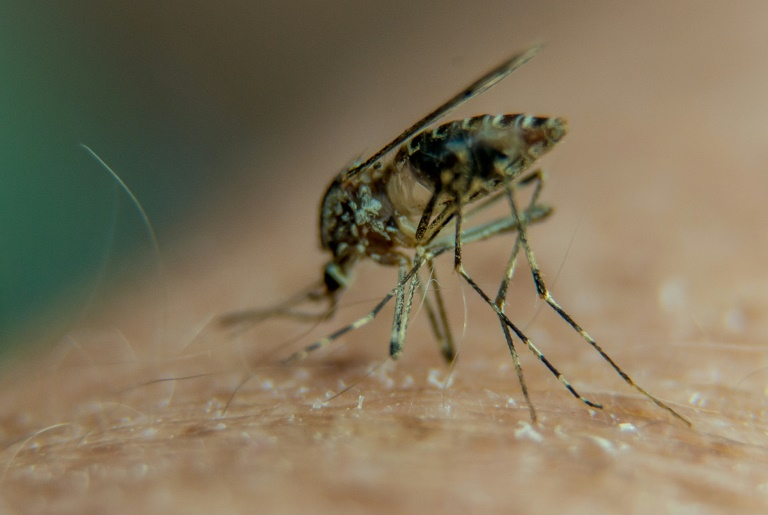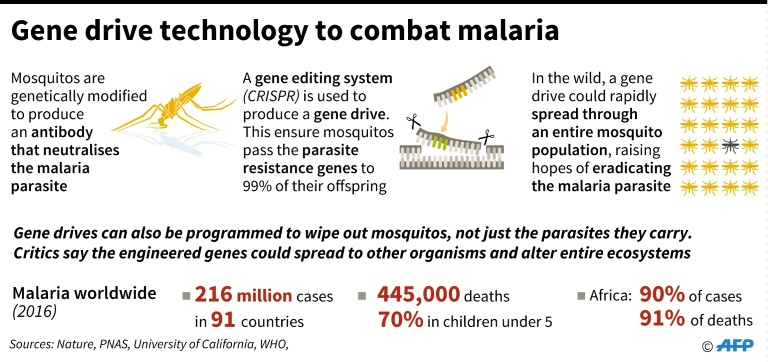Genetic tool that can doom a species under UN review

Proponents of gene drive technology say it can wipe out invasive species and eradicate malaria-bearing mosquitoes. Image: Philippe Huguen / AFP
For some, a new cutting-edge technology called gene drive is the silver bullet able to wipe out invasive species decimating island wildlife, and eradicate the malaria-bearing mosquitoes that killed nearly half a million people last year, mostly in Africa.
Others fear that the genetic engineering process is a one-way ticket to ecological mayhem, or suspect health and conservation aims are masking industrial and military objectives.
Advocates and critics square off in Montreal this week in an obscure working group under the Convention on Biological Diversity, a 1992 UN treaty forged as a bulkhead against the gathering pace of extinction on our planet.
The Ad-Hoc Technical Experts Committee on synthetic biology, known as AHTEG, is tasked with understanding science’s increasingly powerful ability to manipulate genomes, and reporting back to the Convention’s 195 member states.
That both sides of the gene drive debate may have valid arguments shows just how little is still known about this technology, or what might happen if it is ever released into the natural world.
One side, however, clearly has more resources.
A handful of backers — including the US military’s Defense Advanced Research Projects Agency (DARPA) and the Bill and Melinda Gates Foundation — have poured several hundred million dollars into gene drive research over the last two years.
Canada-based consulting firm Emerging Ag said the Gates Foundation paid it $1.6 million dollars this summer to push back against a moratorium on research called for last December by more than 100 NGOs.
“The goal was to reach out to policy makers,” Isabelle Cloche, vice president for strategy at Emerging Ag, told AFP.
Gene drive technology works by forcing evolution’s hand, ensuring that an engineered trait is passed down to a higher proportion of offspring — across many generations — than would have occurred naturally.
Imagine that the trait in question is being male.
In a rapidly reproducing species, the result will be a cascading reduction in population — or even extinction.
Dashed hopes

Image: Gillian Handyside / AFP
Gene drive was first identified as a potential savior for animals decimated by non-native species — such as rodents and mosquitoes — in a 2014 study led by MIT scientist Kevin Esvelt.
“Reducing populations of environmentally and economically destructive invasive species” was among the many “compelling opportunities” offered by the technology, he and colleagues wrote at the time.
Today, Esvelt says he was mistaken to raise the hopes of conservationists, and that unbridled gene drive is too dangerous to be used for that purpose.
“You should never build and release a self-propagating drive system — or really any kind of system — that is capable of definitely spreading beyond the target population,” he told AFP.
“And that rules out invasive species control, because there is always a native population somewhere.”
But Esvelt does not exclude more limited forms of gene drive, nor other targets, notably the eradication of mosquito-borne disease in humans.
In that case, he points out, “your target population is every mosquito of that species”.
Harnessing gene-editing technology to weed out malaria-transmitting mosquitoes from sub-Saharan Africa is precisely the goal of Target Malaria, a non-profit research consortium backed by the Gates Foundation.
“Imposing a moratorium on such promising, life-saving and life-improving innovations so early in their development would be unwarranted, damaging and irresponsible,” the group said last December in response to the moratorium push.
Todd Kuiken, a researcher at North Carolina State University and a member of AHTEG, agrees.
“From a science perspective, putting a blanket moratorium on gene drive research just doesn’t make sense to me,” he told AFP. “You can’t learn anything if you can’t study it.”
Accidental misuse
But Kuiken does draw the line when it comes to funding from the military.
When his university got a $6.4 million grant from DARPA to participate in a programme targeting invasive rodents, he opted out.
“It is possible that DARPA’s work is bending the entire field of synthetic biology towards military applications,” Kuiken said.
His concern is shared by AHTEG member Jim Thomas of the ETC Group, an NGO monitoring new technologies that often race ahead of regulatory frameworks.
“The fact that gene drive development is now being primarily funded and structured by the US military raises alarming questions about this entire field,” he told AFP.
But DARPA spokesman Jared Adams said the US military’s approach was mainly precautionary in the face of “risks that arise from the rapid development and democratization of gene editing tools”.
“This convergence of low cost and high availability means that applications for gene editing —- both positive and negative -— could arise from people or states operating outside of the traditional scientific community and international norms,” he told AFP by email.
Adams acknowledged a “notional estimate” of about $100 million dollars in project funding — substantially more than the $65 million in grants announced in July.
“It is incumbent on DARPA to perform this research and develop technologies that can protect against accidental and intentional misuse,” he added. AB
RELATED STORIES:
Human form of ‘mad cow’ disease detectable in skin: study
New species of wasp discovered by college student
WATCH: Male mantis continues to mate with partner, even without a head